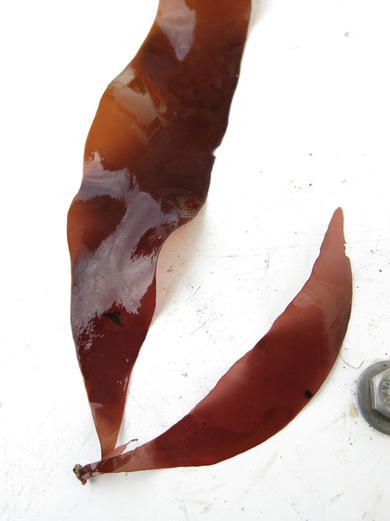Stiff red ribbon, leathery dulse • Palmaria hecatensis
• Heiltsuk/Haíɫzaqv - ƛ̓áx̌vstus h̓ṃ́h̓áṇxs wáwádi*
{Palmaria = reference to the somewhat hand-shaped blades exhibited by some species of this genus; hecatensis = reference to Hecate Strait, the location of the specimens originally described for this species}
*literal translation = "red ribboned kelp"
|
Identification
This red seaweed has a leathery texture, with fairly shiny and thick dark red or reddish-brown blades. The blades reach 20 cm long, are strap-shaped (ligulate), and either unbranched or divided into 2 or 3 lobes with rounded tips. The bases of the blades are tapered into a disc-shaped holdfast. Habitat & Range Stiff red ribbon attaches to rock in the mid to low intertidal, and tends to form substantial fringes. It is found in semi-exposed habitats from the Aleutian Islands in Alaska to northern California; it is a common species in Alaska, but south from there it is infrequent and only found in locations on isolated outer coasts. It is also found along the coast of Russia. Similar Species Red ribbon (Palmaria mollis) is thinner, shaped more like a glove, and has less rounded blade tips. It is usually found below stiff red ribbon in the intertidal. |
Human Uses
This species is edible. It pops like popcorn when dried, cut into small pieces, and fried in hot oil.
iNaturalist
https://www.inaturalist.org/taxa/544682-Palmaria-hecatensis
This species is edible. It pops like popcorn when dried, cut into small pieces, and fried in hot oil.
iNaturalist
https://www.inaturalist.org/taxa/544682-Palmaria-hecatensis
References
Gabrielson, Paul W., Thomas Benjamin Widdowson, and Sandra C. Lindstrom. Keys to the seaweeds and seagrasses of southeast Alaska, British Columbia, Washington, and Oregon. No. 8. University of British Columbia, 2012.
Lamb, A., and Hanby, B. (2005). Marine Life of the Pacific Northwest [electronic version]. Madeira Park, BC: Harbour Publishing.
Lindberg, M. and Lindstrom, S. (2010). Palmaria hecatensis Stiff Red Ribbon. Seaweeds of Alaska. Accessed 06/06/2016.
O'Clair, R. and Lindstrom, S. Palmaria hecatensis M. W. Hawkes. In Klinkenberg, Brian. (Ed.). E-Flora BC: Electronic Atlas of the Plants of British Columbia. Lab for Advanced Spatial Analysis, Department of Geography, University of British Columbia, Vancouver. Accessed 06/06/2016.
Authors and editors of page
Kelly Fretwell (2016).
Gabrielson, Paul W., Thomas Benjamin Widdowson, and Sandra C. Lindstrom. Keys to the seaweeds and seagrasses of southeast Alaska, British Columbia, Washington, and Oregon. No. 8. University of British Columbia, 2012.
Lamb, A., and Hanby, B. (2005). Marine Life of the Pacific Northwest [electronic version]. Madeira Park, BC: Harbour Publishing.
Lindberg, M. and Lindstrom, S. (2010). Palmaria hecatensis Stiff Red Ribbon. Seaweeds of Alaska. Accessed 06/06/2016.
O'Clair, R. and Lindstrom, S. Palmaria hecatensis M. W. Hawkes. In Klinkenberg, Brian. (Ed.). E-Flora BC: Electronic Atlas of the Plants of British Columbia. Lab for Advanced Spatial Analysis, Department of Geography, University of British Columbia, Vancouver. Accessed 06/06/2016.
Authors and editors of page
Kelly Fretwell (2016).





